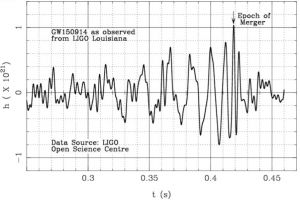2016年IOAA理论第11题-引力波
本题目目前没有解答。要不要你来试试! |
|
英文题目
(T11) Gravitational Waves
The first signal of gravitational waves was observed by two advanced LIGO detectors at Hanford and Livingston, USA in September 2015. One of these measurements (strain vs time in seconds) is shown in the accompanying figure. In this problem, we will interpret this signal in terms of a small test mass 𝑚 orbiting around a large mass 𝑀 (i.e., 𝑚 ≪ 𝑀), by considering several models for the nature of the central mass.
The test mass loses energy due to the emission of gravitational waves. As a result the orbit keeps on shrinking, until the test mass reaches the surface of the object, or in the case of a black hole, the innermost stable circular orbit – ISCO – which is given by 𝑅ISCO = 3𝑅sch, where 𝑅sch is the Schwarzschild radius of the black hole. This is the “epoch of merger". At this point, the amplitude of the gravitational wave is maximum, and so is its frequency, which is always twice the orbital frequency. In this problem, we will only focus on the gravitational waves before the merger, when Kepler’s laws are assumed to be valid. After the merger, the form of gravitational waves will drastically change.
(T11.1) Consider the observed gravitational waves shown in the figure above. Estimate the time period, 𝑇0 , and hence calculate the frequency, 𝑓0 , of gravitational waves just before the epoch of merger.
(T11.2) For any main sequence (MS) star, the radius of the star, 𝑅MS, and its mass, 𝑀MS, are related by a power law given as,
$$\begin{align*} R_{MS}&\propto(M_{MS})^\alpha\\ where\ \alpha&=0.8\ for\ M_⊙\lt M_{MS}\\ &=1.0\ for\ 0.08M_⊙\leq M_{MS}\leq M_⊙ \end{align*} $$
If the central object were a main sequence star, write an expression for the maximum frequency of gravitational waves, 𝑓MS, in terms of mass of the star in units of solar masses (𝑀MS/𝑀⊙) and 𝛼.
(T11.3) Using the above result, determine the appropriate value of 𝛼 that will give the maximum possible frequency of gravitational waves, 𝑓MS,max for any main sequence star. Evaluate this frequency.
(T11.4) White dwarf (WD) stars have a maximum mass of 1.44 𝑀⊙ (known as the Chandrasekhar limit) and obey the mass-radius relation 𝑅 ∝ 𝑀−1/3 . The radius of a solar mass white dwarf is equal to 6000 km. Find the highest frequency of emitted gravitational waves, 𝑓WD,max , if the test mass is orbiting a white dwarf.
(T11.5) Neutron stars (NS) are a peculiar type of compact objects which have masses between 1 and 3𝑀⊙ and radii in the range 10 − 15 km. Find the range of frequencies of emitted gravitational waves, 𝑓NS,min and 𝑓NS,max, if the test mass is orbiting a neutron star at a distance close to the neutron star radius.
(T11.6) If the test mass is orbiting a black hole (BH), write the expression for the frequency of emitted gravitational waves, 𝑓BH, in terms of mass of the black hole, 𝑀BH , and the solar mass 𝑀⊙.
(T11.7) Based only on the time period (or frequency) of gravitational waves before the epoch of merger, determine whether the central object can be a main sequence star (MS), a white dwarf (WD), a neutron star (NS), or a black hole (BH). Tick the correct option in the Summary Answersheet. Estimate the mass of this object, 𝑀obj, in units of 𝑀⊙.
中文翻译
(T11) 引力波
2015年9月,两个先进的LIGO探测器在美国汉福德和利文斯顿观测到了首个引力波信号。其中一个测量值(应变与时间(单位为秒))如下图所示。在这个问题中,我们将通过考虑中心质量性质的几个模型,用一个质量为$$m$$的试验质量围绕质量为$$M$$的大质量物体($$m \ll M$$)旋转来解释这一信号。
由于引力波的发射,试验质量会损失能量。因此,其轨道继续收缩,直到测试质量到达大质量物体表面,或者在大质量物体是黑洞的情况下,达到最内部稳定的圆轨道(ISCO,由$$R_{\rm ISCO}=3R_{\rm sch}$$给出,其中$$R_{\rm sch}$$是黑洞的史瓦西半径)。这是“合并时期”。在这时,引力波的振幅是最大的,它的频率也是最大的,这一频率总是轨道频率的两倍。在这个问题中,我们只关注合并前的引力波,假设开普勒定律成立。合并后,引力波的形式将发生巨大变化。
(T11.1) 考虑上图所示的观测引力波。估计时间周期$$T_0$$,然后计算合并前引力波的频率$$f_0$$。
(T11.2) 对于任何主序星(MS),恒星的半径$$R_{\rm MS}$$及其质量$$M_{\rm MS}$$有幂律关系,如下所示,
\[ \begin{align*} R_{\rm MS} & \propto (M_{\rm MS})^\alpha,\\ {其中,} \alpha & = \begin{cases} 0.8 & M_\odot<M_{\rm MS},\\ 1.0 & 0.08M_{\rm MS}\le M_{\rm MS} \le M_\odot. \end{cases} \end{align*} \]
如果中心天体是主序星,用恒星质量(以太阳质量$$M_{\rm MS}/M_\odot$$为单位)和$$\alpha $$来表示引力波的最大频率$$f_{\rm MS}$$。
(T11.3) 使用上述结果,确定$$\alpha $$的值,使得主序星的引力波频率达到最大值$$f_{\rm MS,\ max}$$。计算这个频率。
(T11.4) 白矮星(WD)的最大质量为$$1.44 M_\odot$$(称为钱德拉塞卡极限),并服从质量-半径关系$$R\propto M^{-1/3}$$。太阳质量白矮星的半径等于$$6000 \rm{km}$$。如果试验质量围绕白矮星运行,求出发射引力波的最高频率$$f_{\rm WD,\ max}$$。
(T11.5) 中子星(NS)是一种特殊类型的致密天体,其质量在$$1\sim 3 M_\odot$$之间,半径在$$10\sim 15\rm{km}$$范围内。如果试验质量绕中子星运行的距离接近中子星半径,求出发射引力波的频率范围$$f_{\rm NS,\ max}$$和$$f_{\rm NS,\ max}$$。
(T11.6) 如果试验质量围绕黑洞(BH)运行,用黑洞的质量$$M_{\rm BH}$$和太阳质量$$M_\odot$$,表示所发射引力波的频率$$f_{\rm BH}$$。
(T11.7) 仅根据合并时期之前引力波的时间周期(或频率),确定中心天体是否可以是主序星(MS)、白矮星(WD)、中子星(NS)或黑洞(BH)。在答案汇总表中选择正确的选项。估计这个物体的质量$$M_{\rm obj}$$,单位是$$M_\odot$$。

